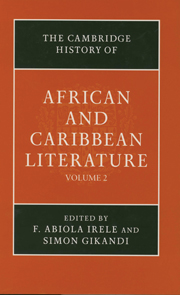Book contents
- Frontmatter
- 23 East African literature in English
- 24 Anglophone literature of Central Africa
- 25 West African literature in English: beginnings to the mid-seventies
- 26 South African literature in English
- 27 African literature in French: sub-Saharan Africa during the colonial period
- 28 North African literature in French
- 29 Francophone literatures of the Indian Ocean
- 30 African literature in Spanish
- 31 African literature in Portuguese
- 32 Popular literature in Africa
- 33 Caribbean literature in French: origins and development
- 34 Caribbean literature in Spanish
- 35 Anglophone Caribbean literature
- 36 The Harlem Renaissance and the Negritude movement
- 37 Postcolonial Caribbean identities
- 38 African literature and post-independence disillusionment
- 39 “Postcolonial” African and Caribbean literature
- 40 Modernism and Postmodernism in African literature
- Index
- References
32 - Popular literature in Africa
Published online by Cambridge University Press: 28 March 2008
- Frontmatter
- 23 East African literature in English
- 24 Anglophone literature of Central Africa
- 25 West African literature in English: beginnings to the mid-seventies
- 26 South African literature in English
- 27 African literature in French: sub-Saharan Africa during the colonial period
- 28 North African literature in French
- 29 Francophone literatures of the Indian Ocean
- 30 African literature in Spanish
- 31 African literature in Portuguese
- 32 Popular literature in Africa
- 33 Caribbean literature in French: origins and development
- 34 Caribbean literature in Spanish
- 35 Anglophone Caribbean literature
- 36 The Harlem Renaissance and the Negritude movement
- 37 Postcolonial Caribbean identities
- 38 African literature and post-independence disillusionment
- 39 “Postcolonial” African and Caribbean literature
- 40 Modernism and Postmodernism in African literature
- Index
- References
Summary
“Popular” is one of the most elusive concepts to define within the context of African studies. An attempt to understand this aspect of African culture should begin with a simple but generally over looked premise: that “popular” is a fugitive concept, because theoretically oriented critics have tended to use the term to designate whatever each one of them has wanted it to mean at a particular place or context, and time. Having to depend – far more than any other expression in the scholarly discourse in the field – on the caprices, the whims, convenience, and moods of its users for its continuing circulation, the very malleability of the word has not only allowed “popular” to serve a variety of purposes but it has made it to be a phrase without a clear meaning.
The consequences of scholars’ inability to settle for any fixed definitions of “popular” are real, although continually disregarded. Not being able to delimit the contours of the popular may have provided unlimited room for those attempting to write theoretical essays about the field, but it has also led to methodological uncertainty and instability as well as ideological confusion. There has been a tendency for each aspiring theorist, viewing an aspect of this heterogeneous body of material from his or her own limited standpoint, to believe and to argue strongly that the part seen, the element encountered and seized upon by the individual scholar, is all there is to see. And so, as each scholar has been mistaking a part for the whole, what we have come face to face with in studies of the popular cultural expression in Africa is a situation that calls attention to itself as a crisis in the modes of investigation.
- Type
- Chapter
- Information
- The Cambridge History of African and Caribbean Literature , pp. 626 - 642Publisher: Cambridge University PressPrint publication year: 2000

